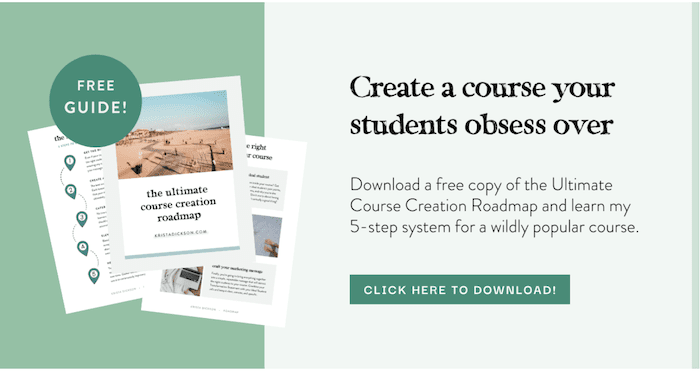The Secret To A Wildly Profitable Course Launch

Here’s where I see so many entrepreneurs go wrong with their course launch…
They get so excited and wrapped up in creating the actual course itself that when it finally comes time to sell the course, they throw up a quick post on Instagram inviting people to join, maybe mention it on Facebook a few times… and that’s it.
As an affiliate partner of various brands and sponsored content, HerPaperRoute may earn commission on qualifying purchases. Disclaimer
Uh-oh, zero signups. (Well, hopefully, a few. But probably not as many as they were hoping for.)
My goal is to make sure this ↑ never happens to you. In today’s post, you’ll learn how to plan, schedule, and execute a wildly profitable course launch.
The Secret To A Wildly Profitable Course Launch
Before we get started, make sure you get your free copy of our Course Creation Roadmap!
There is a whole strategy behind every successful course launch.
But in a nutshell, there are 3 elements you simply can not overlook.
The 3 phases of a successful course launch
Contrary to what you may have thought, your launch doesn’t just encompass the 7-10 day period when your course is open for enrollment.
You also need to have a pre-launch and a post-launch phase.
So your launch schedule looks like this:
1. Pre-Launch Phase
2. Cart Open Phase
3. Post-Launch Phase
The timing of each phase in your launch is crucial.
You can play around with these timelines a bit, but for your course launch, here’s what I suggest doing.
The Pre-Launch Phase: 3-4 weeks before the cart opens
The higher the price point of your course, the longer your pre-launch period should be.
You’ll see why when we talk about the goals and tasks you’ll be completing during the pre-launch phase in just a minute.
Also, keep in mind that your pre-launch phase can technically be up to 60 or even 90 days long. But for your first launch, 3-4 weeks is perfect.
The Cart Open Phase: 7-10 days long
Again, this can vary slightly depending on the price of your course and your experience levels, but for your first launch, aim to have your cart open for about a week.
The Post-Launch Phase: 3-6 weeks
This also varies, because the more content you have to create for your course, the longer your post-launch phase will be.
So by now you’re probably thinking:
What exactly am I supposed to be doing during each of these phases?
Don’t I just create my course, throw up a sales page, and open enrollment?
Not quite, my dear.
Your Course Launch Game Plan
Phase 1: The pre-launch
There are two big goals for this phase of your launch:
1. Generate hype, excitement, and interest for your course
2. Grow and nurture your email list so you have a warm audience to sell to
This phase is also when you’ll be putting all the nuts and bolts together for the cart open period, including writing your sales page and sales emails, creating social media graphics, and creating any bonuses you’re offering.
Tasks to Complete in your Pre-Launch Phase:
Here’s a checklist of the tasks you should complete during the pre-launch phase.
1. Publish a relevant blog post or podcast every week leading up to the cart open.
So if your pre-launch phase is 4 weeks long, you’ll publish 4 relevant blog posts or podcasts leading up to the cart open date.
The blog posts should be directly related to the topic of your course and help to establish your expertise on the topic, get people interested, and add subscribers to your list.
2. Create and release a signature lead magnet.
Remember how one of your main goals for the pre-launch phase was to grow your email list with relevant leads? That’s where your signature lead magnet comes in.
During the pre-launch phase, you’re going to create a lead magnet (AKA a freebie) that’s directly related to the topic of your course. Then you’ll share that freebie in every blog post you publish during the pre-launch phase.
The difference between a regular lead magnet and what I call a signature lead magnet is that your signature lead magnet is a bit more general.
In other words, instead of being so micro-specific that it only fits into one particular blog post, you want to create a lead magnet that’s general enough that it fits well in ALL of your pre-launch blog posts.
For example, if you’re launching a Pinterest course your signature lead magnet might be a Pinterest checklist or a set of pin templates.
3. Send out weekly emails to your list to warm them up for your course.
In your pre-launch emails, you want to drive traffic to your blog posts, share tips related to your course, and let people know that something exciting is coming.
Don’t feel like you have to keep your course a secret.
That’s a mindset that will likely result in a not-so-profitable course.
Instead, you want to hype up your course ahead of time and let people know when enrollment will be opening.
4. Build excitement about your upcoming course on social media.
Use your social channels to talk about your course, show behind-the-scenes peeks at the course material, and showcase your expertise on the topic. Get people excited to buy!
Phase 2: The cart open phase
Woo! You made it to the big event: the Cart Open Period. This is the 7-10 day span when your course is open for enrollment and those dolla dolla bills are rolling in.
As you probably guessed, your goal for this phase is to share your course and make sales.
Tasks to Complete during the Cart Open Phase:
Here are the 3 tasks you’ll want to complete during your cart-open period.
1. Send 3-7 emails to your email list.
Trust me on this one: The vast majority of your course sales will come from people on your email list.
There’s just something so personal and persuasive about email marketing.
It really does work, so don’t be afraid to send multiple emails to your subscribers during the cart open phase inviting them to join you in your course.
The key is to switch up the emails so they’re all different. You don’t want to send the same sales pitch over and over all week long.
Here are a few topic ideas for your launch emails:
- Answer “Frequently Asked Questions” about your course or the course topic
- Share your inspiration behind creating this course
- Share your own story, the struggles you’ve overcome, and where you’re at today
Always include at least one strong, clear call-to-action in each email, encouraging your subscribers to check out the course and see if it’s the right fit for them.
It sounds simple, but if you never ask them to click and check it out, they probably won’t.
2. Promote your course on social media.
This one’s probably a given, but don’t forget to shout out your course daily on your social media channels during your launch.
Remember, the average consumer needs to see something 7-9 times (if not more) before they buy.
3. Optional: Host a live event, a webinar, or a free 5-day challenge.
If you’re feeling comfortable with your launch and you have some extra time available, you may want to host some kind of free event.
I love doing a live workshop during my launches and then inviting my workshop attendees to join me in my course at the end.
If you feel ready to try a more advanced strategy, definitely give this a go!
Phase 3: The post-launch phase
Phewf. You did it! You launched your course, welcomed in your students, and now the doors are closed.
What’s next? You might be tired, but your work isn’t done quite yet…
A lot of course creators don’t create a Post-Launch strategy, but it’s super important. Your two big goals for the post-launch phase are to:
1. Educate and interact with your new course students
2. Engage with your new subscribers who didn’t buy the course (this time!)
Tasks to Complete During the Post-Launch Phase
Here’s what you’ll be working on during this phase.
1. Creating the course material
If you’re running a beta round for your course (which I highly suggest), you won’t have much of your course content created at this point.
Instead, you’ll be creating it live and releasing one new module for your students to work through each week.
2. Checking in with your new students.
This can be done via your email list or within your course community (e.g., a Facebook group).
It’s important to motivate your students every week, because over time, their ambition and excitement will wane and they’ll be less likely to keep progressing through the course.
Continue reminding your students why they purchased your course in the first place and of all the amazing results that are waiting for them if they put their heads down and keep doing the work.
Another benefit of checking in with your students is that you’ll be able to get feedback, and possibly some awesome testimonials, from your first round of students.
This will make it that much easier to launch and sell your course the next time around.
3. Sending follow-up emails to your new subscribers who didn’t buy.
What about all those people who opted into your signature lead magnet in the pre-launch phase or who signed up for your webinar or free challenge but didn’t end up buying?
The post-launch phase is when you want to continue wooing these people.
It’s super important that in this phase, you make your new subscribers feel welcome and re-introduce yourself to people who are brand new to your list.
I have an entire blog post on writing a killer welcome series if you need help.
Make sure you send out emails that are specific and targeted.
I suggest sending a series of 3-4 emails over a 2-week period where you:
- Re-introduce yourself to your new subscribers and highlight your expertise
- Let them know that it’s totally cool that they didn’t buy your course this time around
- Share some free resources, gifts, and tools related to the topic of your course
- Tell them what they can expect from you moving forward
Once your post-launch phase is in the books, give yourself a huge hug and high-five. You just successfully executed your course launch! It can seem a little daunting, but launching does get easier over time.
Every time you launch your course, you’ll learn new techniques that help you improve your strategies and make more money. I’ve actually grown to love launching, which is something I never thought I’d say!
Have you launched a course before?
If so, how did it go? Did you incorporate all of these three phrases in your launch?
Let me know in the comments section below what questions you have about launching!
Now, if you haven’t already, download your free copy of my course planning roadmap kit:

Follow along on Instagram!






![How To Create An Online Course [Ultimate Guide] 8 the ultimate guide on how to create an online course for successful creators](https://herpaperroute.com/wp-content/uploads/2017/12/the-ultimate-guide-on-how-to-create-an-online-course-for-successful-creators-768x410.jpg)




